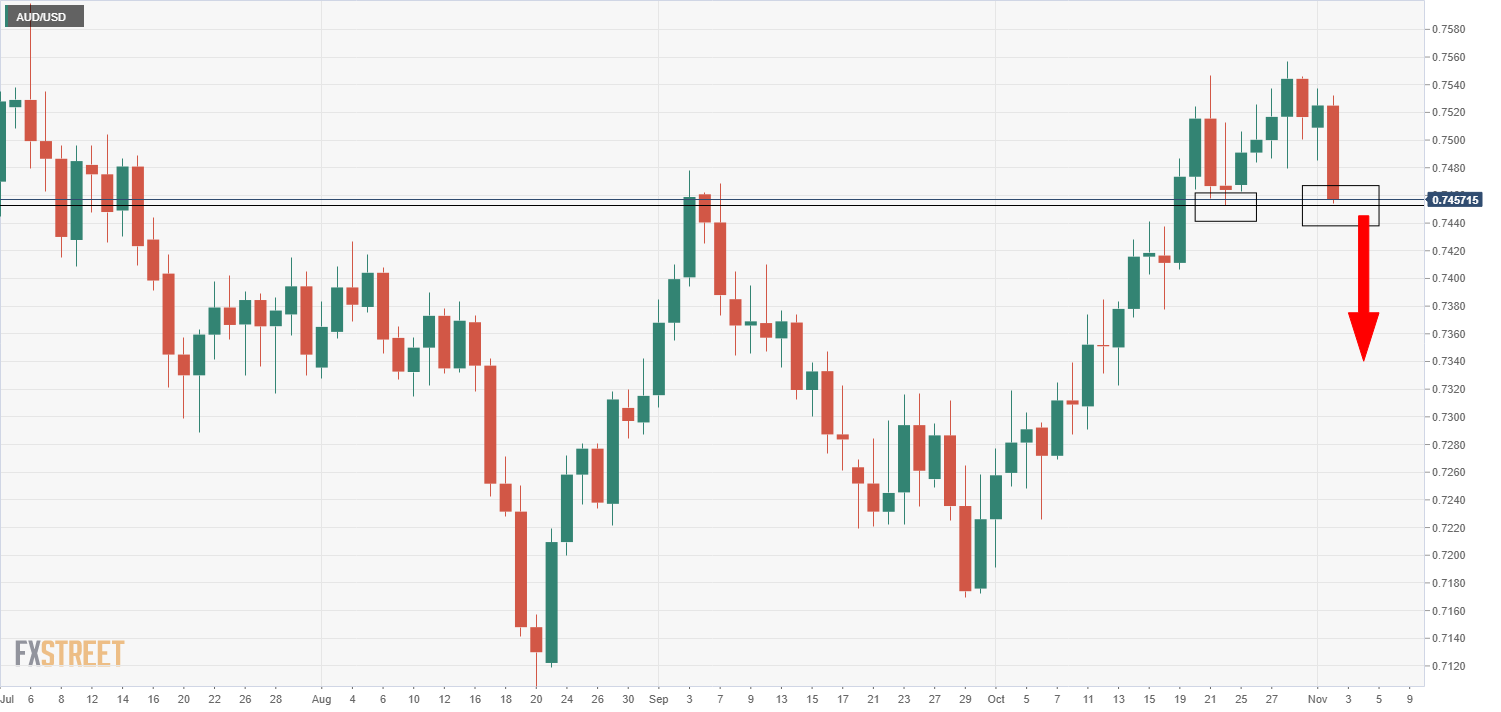AUD/USD stabilises just above 0.7450, still worst G10 performer on the day
- The pace of Tuesday’s pullback in AUD/USD has slowed in recent trade, with some support being found at 0.7450.
- The Aussie is the worst G10 performer amid a drop in iron ore prices and after a dovish RBA.
Though it remains the worst-performing currency in the G10 on the day, AUD/USD downside has abated in recent trade, with the pair seemingly finding some support at the 21 and 22 October lows just above the 0.7450 mark.
The Aussie has been weighed heavily thus far on Tuesday by two key factors; 1) the governor of the Reserve Bank of Australia (RBA) Philip Lowe delivered a stronger than expected pushback against the hawkish pricing of Australian money markets that sees rate hikes coming as soon as 2022 and 2) a sharp decline in Chinese iron ore prices that saw futures on the Dalian exchange drop 10% and hit their “limit down” amid panic about weak demand as molten iron output is curbed as power is conserved for the coming winter heating season and with a view to ensuring air quality for the winter Olympics – remember, one of Australia’s key exports to China is iron ore.
RBA Recap
Just to quickly recap last night’s RBA event; the bank held interest rates at 0.1% and maintained the pace of weekly bond-buying at A$ 4B, as expected. The bank also announced an end to its yield curve control policy, where it had been attempting to keep the yields on all government bonds maturing until April 2024 at 0.1%, saying the policy had become inefficient – the real reason it because markets were forcing them to abandon the policy, with the yield on the April 2024 surging last week to well above 0.1%, leaving the RBA in a situation where they would have to purchase billions in order to defend the yield target, a cost they seemingly decided it was not worth incurring. This move was expected after the RBA refrained from preventing the yield spike last week.
The RBA does seem to have surprised investors, however, with the strength of the pushback against the market’s aggressive pricing for near-term rate hikes. RBA Governor Lowe was incredulous towards the prospect of a rate hike as soon as 2022 and was critical of the market pricing as an “overreaction” to global inflation data. The RBA did concede that it could now see hiking rates as soon as 2023, though a first-rate hike in 2024 also remains very possible and the outlook for rates is now more uncertain than before. This is because, whilst global inflationary pressures have clearly risen, the extent to which that affects Australia remains unknown and that wage growth (which the RBA sees as a key long-term driver of inflation) is still forecasted to remain subdued until at least 2023.
What next for AUD?
AUD/USD traders now await major economic events in the US, including Wednesday’s FOMC meeting and Friday’s US jobs report, but will also be on notice for the release of the RBA’s Statement on Monetary Policy (and new economic forecasts) during Friday’s Asia Pacific session.
ING think that AUD is yet to reflect the extent of the recent move higher in short-end Australian rates (to reflect hawkish RBA bets), and is thus undervalued, despite money markets modestly dialing down these hawkish bets in wake of last night’s RBA announcement. The bank argues that this undervaluation combined with the fact that, according to the latest CFTC positioning data, the market remains very short AUD, means there are upside risks for the Aussie in the near term. MUFG disagree, with last night’s RBA meeting emphasising to them that the central bank is set to lag the Fed, RBNZ, BoE, BoC and Norges Bank in terms of monetary policy normalisation, which may weigh on the Aussie in the coming weeks, which, when combined with negative technical pressures after AUD/USD failed to break above its 200DMA, means risks are tilted to the downside.

